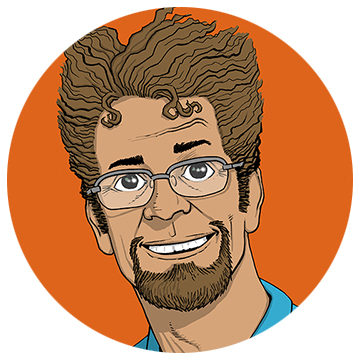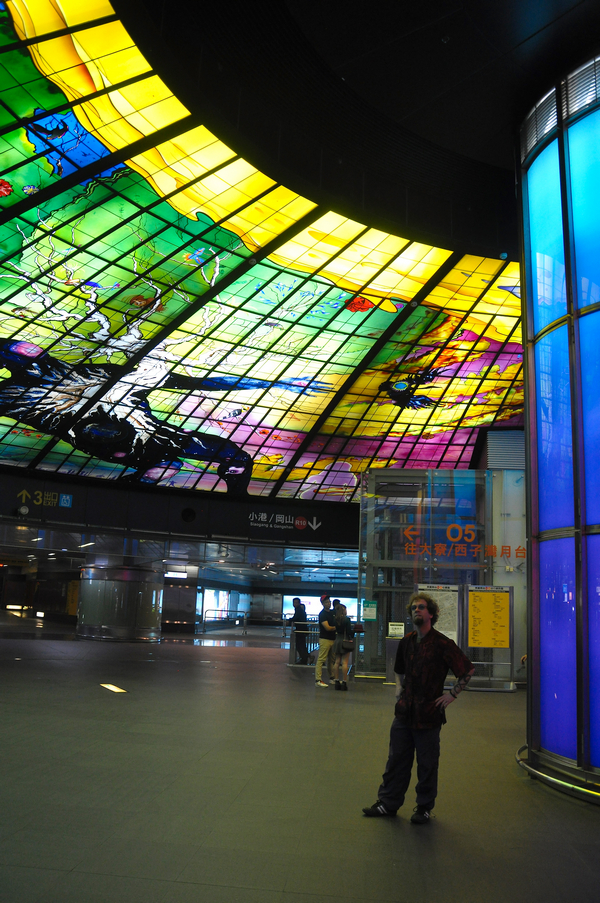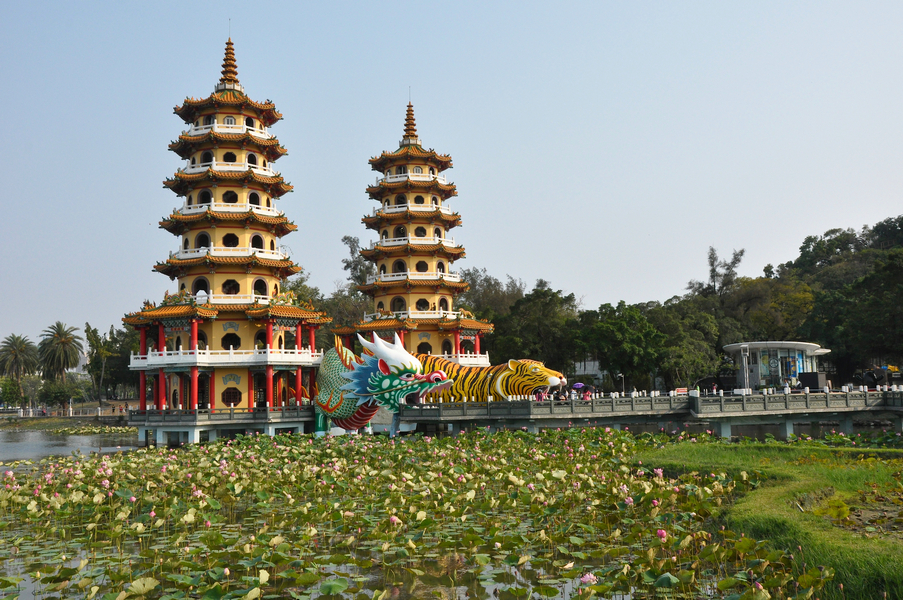Formosa Moon
Failure and Success in the LA of Taiwan

Source:Authors At Work (Photo by Tobie Openshaw)
Notes from a Small Island meets Eat Pray Love on the Tropic of Cancer, Formosa Moon is a dual-voiced cultural exploration around Taiwan undertaken by Joshua Samuel Brown (a long-time resident and author of three other books on Taiwan) and Stephanie Huffman (a first-time visitor who’s reluctantly agreed to relocate sight unseen), a sneak excerpt of which to kick off our featured #Taiwander submission series.
Views
Failure and Success in the LA of Taiwan
By Joshua Samuel Brown, Stephanie Huffmanweb only
If one wanted to tell a beautiful story about Taiwan, what would it be?
Would it feature the island’s majestic mountain range or its winding coastline? Or highlight the vibrancy of its rural villages or the cosmopolitan spirit of its metropolitan areas? There’s one thing, of course, that must not be left out - the island’s most beautiful feature – the Taiwanese human touch, the kindness of the people here.
In the course of our everyday lives, we can see Taiwan’s diversity and variety. Through quality tourism based on authentic local experiences, we can make Taiwan a place for living the good life. This spectacular isle offers endless adventures. Let’s invite #Taiwanders from around the world to join the fun!
The following is a sneak exerpt from Formosa Moon, a dual-voiced cultural exploration around Taiwan undertaken by Joshua Samuel Brown (a long-time resident and author of three other books on Taiwan) and Stephanie Huffman (a first-time visitor who’s reluctantly agreed to relocate sight unseen).
 We'd come to Kaohsiung for two reasons: First, looking for an epiphany about Kaohsiung, and second, to meet the mayor of Kaohsiung.
We'd come to Kaohsiung for two reasons: First, looking for an epiphany about Kaohsiung, and second, to meet the mayor of Kaohsiung.
We failed on both counts, but had a good time nonetheless.
Despite my many years in Taiwan, I'd not spent much time in its second largest and southernmost city. This was largely by design. Kaohsiung lacks the cultural cache of Tainan, its nearest urban neighbor, and most of what the city is known for - a harbor, heavy industry, and perpetual haze - isn't all that attractive to tourists, who tend to use Kaohsiung (and it's High Speed Rail terminus) as a jumping off point for greener and sandier points south.
I'd often heard Taipei, a city I love, disparaged by people who'd only passed through. Kaohsiung is, after all, Portland's sister city in Taiwan, so Stephanie and I both felt a fraternal obligation to give it the full open-minded travel writer treatment and to meet its mayor, Kiku Chen.
Already in the deep south following yesterday's compellingly violent puppet show, we boarded the train to Kaohsiung determined to hit the ground running in search of the aforementioned epiphany as to what makes the city tick.
Alas, Stephanie's gluten allergy had other plans. The culprit was a bag of potato snacks from Thailand, bought in a rush at the train station. Stephanie had already eaten a mouthful when I noted that wheat flour was listed second on the ingredient list.
"Sh*t. I fed you wheat," I said, showing her the bag. "You want to go make yourself puke?"
"I never was able to self-induce vomiting," Stephanie said, reaching into her passport pouch for her emergency Benadryl pill.
By the time we reached Kaohsiung station, the antihistamine was kicking in, and Stephanie seemed slightly loopy as we walked along the canal towards the Howard Hotel, where we were greeted by Amy, the hotel manager who'd arranged our stay, and another woman in full Snow White regalia. As Amy welcomed Stephanie and I to Kaohsiung, Snow White presented Stephanie, who was now slightly swaying side to side from the combined effects of gluten intolerance and Benadryl, with a bag of multicolored cookies, which I took (and later consumed on her behalf).
 Kaohsiung's Formosa Boulevard Station (Image: Joshua Samuel Brown)
Kaohsiung's Formosa Boulevard Station (Image: Joshua Samuel Brown)
(Read: Formosa Boulevard Station: The Most Beautiful MRT Station, Charming from Inside Out)
Our room on the Howard's 26th floor offered a lovely view of the Kaohsiung Skyline, which has some impressively strange buildings, most notably Kaohsiung 85, which, contrary to popular belief is not "Kaohsiung's answer to Taipei 101", having preceded the better known Taiwan tower by several years. In addition to being tall, K85 boasts an interesting prong design, with two separate 39-floor sections meeting a single central tower hovering over a large open space vaguely resembling the kao (高) character in Kaohsiung.
Lovely and luxurious, more business than ostentatious, our room at the Howard also had two other features that Stephanie appreciated immediately. An extremely soft bed, which she promptly collapsed on, and blackout curtains, which I used to shut out the increasingly unwelcome sunlight.
"Need to sleep this off…" she mumbled. "Why don't you go out and explore."
And so it was that my first round of exploratory recon was made solo.
An adopted dyed in the wool Taipei-ren, one of the first things I noticed about Kaohsiung is just how relaxed the city is by comparison. The avenues and boulevards are, by a wide margin, wider, and if the sidewalks feel less crowded it's because they are, at 2,400 people per square mile, compared with Taipei's Soylent Green worthy 26,000 people per square mile. Though Taiwan's second largest city, a smaller population spread over a larger area gives Kaohsiung a way less dense feeling.
Kaohsiung is also more orderly than Taipei. Taipei was already an established city by the time the Japanese took over, forcing the famously order-obsessed colonialists to make due with reordering Taipei as a Japanese city over an unforgivably chaotic Chinese foundation. But Kaohsiung was barely farmland with a harbor in the late 19th century, and whoever was in charge of urban planning in the southern quadrant of newly acquired colonial Taiwan must have salivated mightily at the chance of creating in Kaohsiung the sort of meticulously planned city for which the Japanese are justly famous.
With no particular agenda, I wandered the well-ordered grid system of Kaohsiung for several hours, crossing wide avenues at regular intervals, stumbling upon a few quiet parks and a surprising number of betel nut stalls. I passed through the Zhong Xiao Night Market, but it was a few hours before things would really start swinging there. A few of the stalls were open, and I sat down at one for some noodles. The proprietor asked me if I was lost.
"Not accidentally," I replied.
"Most foreigners go to the Liuhe Night Market," he said. "All the signs are in English."
"I'll go there later. This place feels more local."
I finished my noodles and wandered slowly back towards the Howard to see if my own sleeping beauty was emerging from her self-induced coma. I was hoping that her appetite had returned, and despite the earlier incident with the gluten laden snack food, Stephanie would be up for a culinary adventure.

Night markets were definitely growing on me, and though crowded, the one Josh brought me to was, like everything else in Kaohsiung, more relaxed than Taipei. I was starting to enjoy swimming in a stream of people while looking for food, and was finding more and more tasty gluten free items. Soon after entering, we found a booth selling rice stuffed chicken wings. We hadn’t seen this dish since Sun Moon Lake so I eagerly bought two as a first course for dinner. We had the next course at a booth selling shrimp and crab dipped in rice flour. A tasty third round was small strips of beef wrapped around green onions. “Buy ten get one free” the sign advertised in English, and we did, eating them from a small paper sack while walking through the colorful market.
Other dishes were less palatable.
"Taste this. You won’t like it," Josh said, handing me a small orange cube on a toothpick. I sniffed it. Definitely fishy.
"What is it?"
"Grilled mullet roe."
"It tastes like a piece of squid that's been sitting in a dirty ashtray," I said, spitting it out.
"That tiny piece cost 50 NT." Josh replied. "It's considered a delicacy."
"Not to me. Let's grab some fruit to wash the taste out and go clothes shopping."
The slower pace of this night market gave me more time to explore the clothing booths. I happily bought a pair of culottes in a crisp dark blue. They had pockets which had become a necessity for my travel clothing. Another vendor was selling belts with spandex pockets perfect for wallets, passports and mobile phones. “Invented in Taiwan,” he told us with pride. Though we could not confirm the claim, we were duly impressed nonetheless, and bought three before heading back to the hotel.
 The next day we explored the city by metro. Like their more numerous Taipei counterparts, Kaohsiung metro station platforms have screens every few feet playing commercials, public service announcements and other short features in scheduled rotation. Even these are somehow more relaxed in Kaohsiung, with individual segments running up to 40 seconds as opposed to the hyperactive segments in the Taipei Metro.
The next day we explored the city by metro. Like their more numerous Taipei counterparts, Kaohsiung metro station platforms have screens every few feet playing commercials, public service announcements and other short features in scheduled rotation. Even these are somehow more relaxed in Kaohsiung, with individual segments running up to 40 seconds as opposed to the hyperactive segments in the Taipei Metro.
At the Formosa Boulevard station, we stopped under the "Dome of Light", a multicolored glass installation made up of several thousand glass panels. A white piano was set up, and the crowd appeared to be made up equally of people there to enjoy the art and music and people using the metro station specifically to get from one place to another. We had lunch in the food court of one of many beautifully modern air conditioned malls before heading over to the harbor to meet Tommy Wu.
A Kaohsiung native, I'd met Tommy a few months earlier in Tainan through Angela, and he'd offered to show us around one of his favorite childhood spots in the city. This turned out to require a boat ride.
The ferry ride to the slender island of Cijin was our first time on a boat since the infamous Green Island Vomit Comet, but it was far smoother and mercifully short. As the island came into view, Tommy explained that as a child he'd come here often, and that the island hadn't changed all that much since he'd first come as a boy. Cijin's general carnival atmosphere was made more pronounced by the crowds drawn by the three day weekend. The main street running from the pier to the beach was lined on both sides with restaurants serving fresh seafood, and in front of these stood stalls selling everything ranging from ice cream and popsicles to individually grilled oysters and squid on a stick. Though wide, we still found ourselves having to push through the crowds. We walked around for about an hour before heading back to the pier to stand in line with a few thousand other people also looking to get back to the city proper.
"You want to head over to the art district for dinner?" Tommy asked.
The art district turned out to be unexpectedly cool. Tommy explained how, over the last decade Kaohsiung had transformed its western harbor area from industrial to artistic use, simultaneously beautifying the area and helping to shake off the city's industrial reputation. Massive block-long red brick warehouses had been converted into vast cultural complexes with galleries and studios, restaurants and shops. In one, a movie theater was showing a Werner Herzog film. In another, shoppers perused books in a trendy bookstore while out in front a small cart sold cold brew single-origin coffee.
"I called up my wife. She'll come and meet us at the Italian restaurant."
The restaurant was surprisingly good, not just for an Italian restaurant in Taiwan (though to be fair, Italian food is a traveler’s best bet for non-Asian food in Taiwan), but for décor. The restaurant's high ceiling and red brick walls were the only sign of the building's industrial origins.
 While waiting for our food a large art piece on the adjacent wall caught my attention. At first it looked like a stone mandala with Mayan imagery but upon closer inspection I saw computer keys, mice and USB drives. A ring of stones had a mixture of Chinese characters, English letters and punctuation marks and in the center was a tangle of bodies. A marker attributed the piece to local artist Tu Wei-Cheng and explained that it was a reflection on computers, pornography and the internet age. Gate Of The Fleeting Souls was part of a larger multi-site installation series called Bu Num Civilisation. I found it an interesting meditation on how new technology can shape society’s beliefs and values.
While waiting for our food a large art piece on the adjacent wall caught my attention. At first it looked like a stone mandala with Mayan imagery but upon closer inspection I saw computer keys, mice and USB drives. A ring of stones had a mixture of Chinese characters, English letters and punctuation marks and in the center was a tangle of bodies. A marker attributed the piece to local artist Tu Wei-Cheng and explained that it was a reflection on computers, pornography and the internet age. Gate Of The Fleeting Souls was part of a larger multi-site installation series called Bu Num Civilisation. I found it an interesting meditation on how new technology can shape society’s beliefs and values.
Tommy’s wife and son soon joined us for dinner and our conversation was the real joy of the evening. Hiromi was originally from Japan, and having also moved to Taiwan for the man she loved, I found a kindred spirit who could relate to a lot of my recent experiences. She shared her strategies on how to manage a multitude of projects in her already full days; I could relate as I was transitioning into a writer’s life while trying to continue my fiber arts. Hiromi was passionate about conquering new challenges and her tale of teaching herself to play violin at the age of 45 validated my recent efforts to learn Mandarin.
 We wound up spending three days in Kaohsiung, and I'd hoped to come away with some sort of epiphany better than Kaohsiung is a warmer, flatter and more relaxed version of Taipei, or a pithier Kaohsiung is the LA of Taiwan. Alas, no such epiphany presented itself. Our time in Kaohsiung was pleasant, the city was interesting enough to warrant a few days more, and we were glad to have spent time with new friends.
We wound up spending three days in Kaohsiung, and I'd hoped to come away with some sort of epiphany better than Kaohsiung is a warmer, flatter and more relaxed version of Taipei, or a pithier Kaohsiung is the LA of Taiwan. Alas, no such epiphany presented itself. Our time in Kaohsiung was pleasant, the city was interesting enough to warrant a few days more, and we were glad to have spent time with new friends.
But Stephanie and I did have two profoundly moving experiences that illustrated both the character of the city and Taiwanese society in general.
The first of these occurred at a foot massage spa, where we witnessed a profound act of kindness. As we were getting our own massages, we noticed a severely disabled man standing at the front door. He was hunched over, his body twisted from some sort of muscular or neurological disorder. Though the masseuses were blind, the proprietress was sighted, and approached the man.
Traveling in other countries, especially ones with large gaps between rich and poor where tourism is thrown into the mix, I had experienced being singled out as a tourist by beggars. My first thought was this man is a beggar, and having spotted foreign tourists, he is waiting for us to be done to ask us for money. The proprietress, knowing this, is going to shoo the man away.
"What do you want today?" the proprietress asked in a gentle tone, and the man said something in slurred Taiwanese that I could not make out.
With kindness and respect, the proprietress helped the man up and over the raised doorway and walked him over to a massage table. She helped him onto the table, questioning him in gentle tones to ascertain what parts of his body were in discomfort. Lying on the table, the man’s body was even more hunched and twisted, the extent of his disability becoming even clearer.
A moment later, a blind masseuse walked over to the handicapped man and began massaging him, speaking to him in a tone that suggested longstanding familiarity.
"Your lower back and hips hurt today? You just rest, I'll soon fix that."
I can't begin to count all the times I'd witnessed such acts of kindness and human decency in my years in Taiwan. The only exceptional thing about displays of kindness and compassion here is that they are so common as to be unexceptional.
As the scene unfolded, I felt a twinge of shame, not so much for assuming that the man was a beggar, but for assuming that my being there had anything to do with his being there. But I was proud of Taiwan, and glad to be present to bear witness to something so… good.
Massages complete, we headed over to the Dragon and Tiger Pagodas, where Stephanie made her own wishes to guide our personal fortunes and destiny.
 Dragon and Tiger Pagodas (Image: Joshua Samuel Brown)
Dragon and Tiger Pagodas (Image: Joshua Samuel Brown)
(Read: Beauty of Taiwan in the Eyes of Two Danish Timelapsers)
The second moving experience occurred just outside of Kaohsiung City Hall where we'd gone as self-appointed representatives of Portland to present the mayor of our sister city with a deck of playing cards hand drawn by Portland artists. We'd hoped to get a picture of ourselves presenting the gift to the mayor personally, but alas, Ms. Chen was not present and we had to settle for presenting the gift, along with my business card and a note, to her secretary.
We were walking down the sidewalk with an air of slight failure hanging over us when we both noticed a woman sitting on a stopped scooter in the middle of the intersection. She seemed extremely distressed at something, on further observation we could see dozens of crisp thousand NT notes fluttering away from her, carried by the breeze down the middle of the wide boulevard. We joined another pedestrian, and a woman who'd pulled over her car, and between us we managed to rescue somewhere in the vicinity of forty NT $1000 notes.
"Xie xie, xie xie" she kept saying in a quivering voice. She had a look about her like a deer caught in the headlights, simultaneously relieved and embarrassed to have had a bag of money open up in traffic. I asked her if the money was all accounted for, and she nodded. I thought of suggesting a more secure way to transport large amounts of cash - a made in Taiwan spandex money belt, perhaps - but thought better of it. The woman looked as if she had other concerns at the moment.
This incident too served as a reminder of the genuine decency I'd always experienced in Taiwan, a country where your biggest concern on having a bag of money open on a public street is losing it to the wind rather than fellow citizens (or Alien Residents in Contemplation, as in the case of Stephanie and I).
Though the trip had not provided any specific epiphanies about the city of Kaohsiung, we left with a greater appreciation of the overall goodness of Taiwan. And we left liking the city itself enough to want to return. And perhaps this was enough.
This is a sneak exerpt from Formosa Moon, currently availble for pre-order.
About Formosa Moon
Notes from a Small Island meets Eat Pray Love on the Tropic of Cancer, Formosa Moon is a dual-voiced cultural exploration around Taiwan undertaken by Joshua Samuel Brown (a long-time resident and author of three other books on Taiwan) and Stephanie Huffman (a first-time visitor who’s reluctantly agreed to relocate sight unseen).
Part travelogue, part guidebook, Formosa Moon follows the couple as they travel around the island seeking cultural exploration on a deeper level, abandoning themselves to its quirky people, convoluted history and boundless eccentricity.
Pick up your pen or camera and be the next inspirer!








